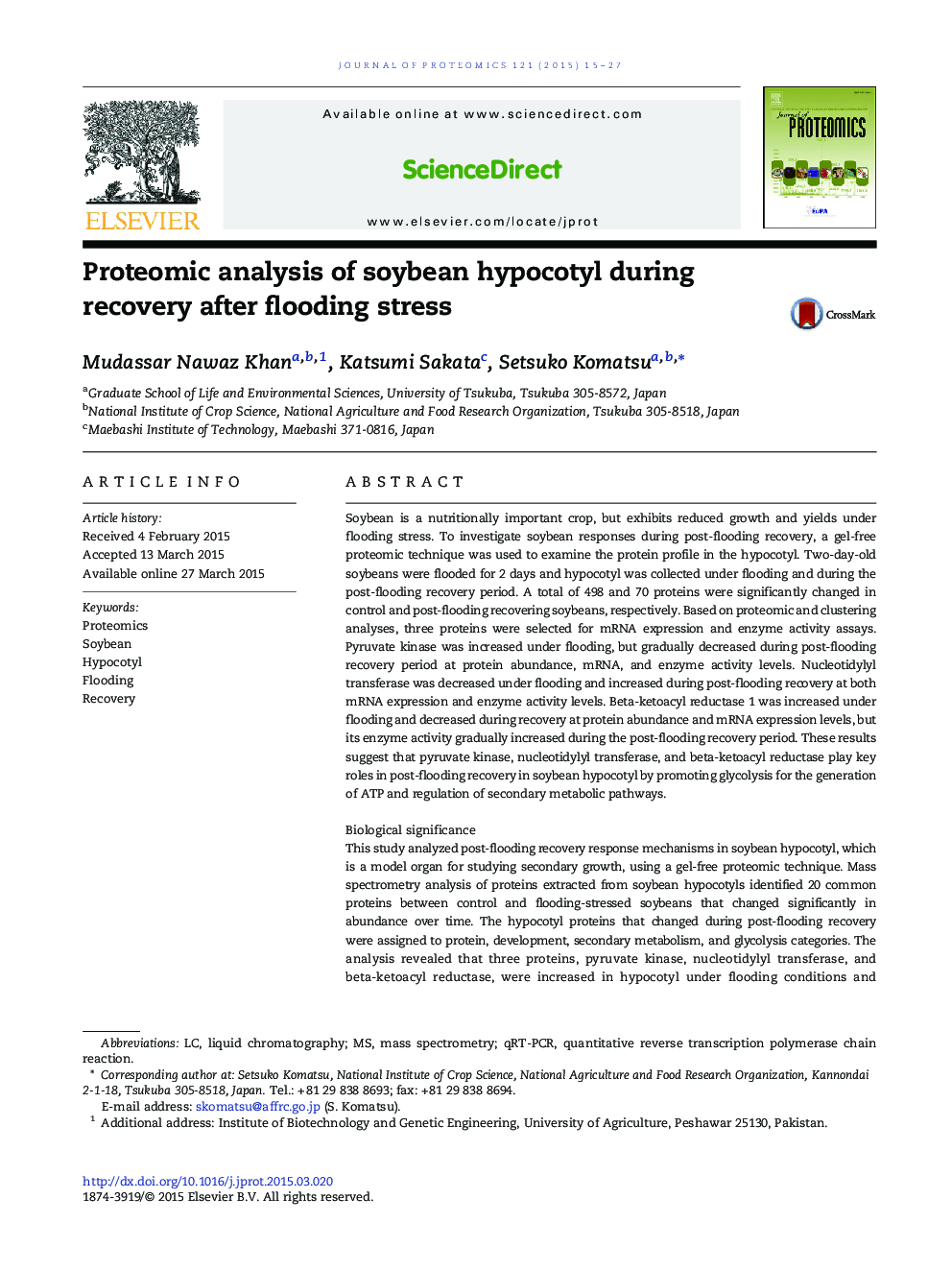| کد مقاله | کد نشریه | سال انتشار | مقاله انگلیسی | نسخه تمام متن |
|---|---|---|---|---|
| 1225425 | 1494759 | 2015 | 13 صفحه PDF | دانلود رایگان |
• Proteomic, mRNA, and enzyme activity level analyses of soybean hypocotyl during post-flooding recovery were performed.
• Seventy proteins were significantly changed during post-flooding recovery.
• Twenty proteins were common between control and flooded seedlings.
• The changed proteins were mainly assigned to protein category.
• Pyruvate kinase, nucleotidylyl transferase, and beta-ketoacyl reductase increased under flooding and early recovery.
Soybean is a nutritionally important crop, but exhibits reduced growth and yields under flooding stress. To investigate soybean responses during post-flooding recovery, a gel-free proteomic technique was used to examine the protein profile in the hypocotyl. Two-day-old soybeans were flooded for 2 days and hypocotyl was collected under flooding and during the post-flooding recovery period. A total of 498 and 70 proteins were significantly changed in control and post-flooding recovering soybeans, respectively. Based on proteomic and clustering analyses, three proteins were selected for mRNA expression and enzyme activity assays. Pyruvate kinase was increased under flooding, but gradually decreased during post-flooding recovery period at protein abundance, mRNA, and enzyme activity levels. Nucleotidylyl transferase was decreased under flooding and increased during post-flooding recovery at both mRNA expression and enzyme activity levels. Beta-ketoacyl reductase 1 was increased under flooding and decreased during recovery at protein abundance and mRNA expression levels, but its enzyme activity gradually increased during the post-flooding recovery period. These results suggest that pyruvate kinase, nucleotidylyl transferase, and beta-ketoacyl reductase play key roles in post-flooding recovery in soybean hypocotyl by promoting glycolysis for the generation of ATP and regulation of secondary metabolic pathways.Biological significanceThis study analyzed post-flooding recovery response mechanisms in soybean hypocotyl, which is a model organ for studying secondary growth, using a gel-free proteomic technique. Mass spectrometry analysis of proteins extracted from soybean hypocotyls identified 20 common proteins between control and flooding-stressed soybeans that changed significantly in abundance over time. The hypocotyl proteins that changed during post-flooding recovery were assigned to protein, development, secondary metabolism, and glycolysis categories. The analysis revealed that three proteins, pyruvate kinase, nucleotidylyl transferase, and beta-ketoacyl reductase, were increased in hypocotyl under flooding conditions and during post-flooding recovery. The proteins are involved in glycolysis, nucleotide synthesis and amino acid activation, and complex fatty acid biosynthesis.
Figure optionsDownload high-quality image (65 K)Download as PowerPoint slide
Journal: Journal of Proteomics - Volume 121, 21 May 2015, Pages 15–27
